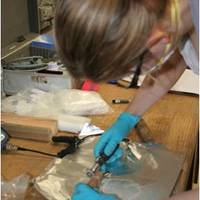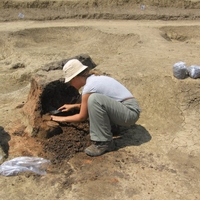Zbornik radova, Znanstveno–stručni skup Biogradsko-benkovački kraj u Domovinskom ratu, Benkovac, 26. rujna 2019. godine, 2019
Ratna djelovanja su sama po sebi intenzivna prostorna praksa što znači da zahvaćaju čitav
prostor... more Ratna djelovanja su sama po sebi intenzivna prostorna praksa što znači da zahvaćaju čitav
prostor. Kao takva interferiraju s materijalnim ostacima iz prošlosti na razini krajolika, što se
prvenstveno odnosi upravo na arheološka kulturna dobra. Najčešći način interferiranja je
narušavanje materijalnog integriteta kulturnog dobra koji nastaje kao kolateralna šteta borbenih
djelovanja kao što su primjerice izgradnje vojnih objekata te postavljanje minsko-eksplozivnih
sredstava na arheološkim lokalitetima čime dobro postaje dugotrajno nedostupno. S obzirom da
ratna šteta na arheološkoj baštini koja je nastala tijekom Domovinskog rata nikada nije sustavno
dokumentirana i utvrđena, cilj ovog rada je prikazati ratnu štetu na arheološkoj baštini na
primjeru benkovačko-biogradskog područja. Procjena ratne štete obuhvaća deiniranje modaliteta
negativnog interferiranja ratnih djelovanja s arheološkom baštinom, vrste šteta, metodologiju
procjene i rezultate na području studije slučaja.











Uploads
Papers by Igor Kulenovic
prostor. Kao takva interferiraju s materijalnim ostacima iz prošlosti na razini krajolika, što se
prvenstveno odnosi upravo na arheološka kulturna dobra. Najčešći način interferiranja je
narušavanje materijalnog integriteta kulturnog dobra koji nastaje kao kolateralna šteta borbenih
djelovanja kao što su primjerice izgradnje vojnih objekata te postavljanje minsko-eksplozivnih
sredstava na arheološkim lokalitetima čime dobro postaje dugotrajno nedostupno. S obzirom da
ratna šteta na arheološkoj baštini koja je nastala tijekom Domovinskog rata nikada nije sustavno
dokumentirana i utvrđena, cilj ovog rada je prikazati ratnu štetu na arheološkoj baštini na
primjeru benkovačko-biogradskog područja. Procjena ratne štete obuhvaća deiniranje modaliteta
negativnog interferiranja ratnih djelovanja s arheološkom baštinom, vrste šteta, metodologiju
procjene i rezultate na području studije slučaja.
Štrkovača and Kruglaš hillforts, a segment of a structure
has been excavated that was made by the simple
technique of laying and packing gravel onto a previously
prepared surface. Based on potsherd finds, the
structure has been dated to the period of late prehistory,
generally in the Bronze Age. This structure has
been interpreted as a road on the basis of morphological
features and its composition, as well as analogies to
similar features.
Site "Oružana " is situated in the immediate vicinity of today's downtown area of Koprivnica. It's named after the town's armory buiilding, that also served as the southeast entrance gates. As a monument, it represents a remaining part of the complex of bulwark, moat, bastions and ravelin outworks. Relatively small part of fortification has been preserved: southeastern bastion, a part of bulwark and moat, southern an (partially) eastern ravelin. The building of Koprivnica fortification had started in second half of 16 th century. Numerous historic documents and blueprints indicate that the fortification was built, rebuilt and reconstructed many times. Archeological reasearch has established at least two of such reconstructions. At one period of time, the Oružana building served as town's entrance gates through a spanning, bascule bridge over water-filled moats. In another phase, Oružana was abandoned as an entrance gate altogether. Instead, the bridge was torn down, new earthen bulwark structures were being added, blocking the building from a direct hit. Further excavations found remains of an older moat, beneath the foundations of the Oružana building. For the time being, it's impossible to determine the full functions and time of building for this moat. In order to stabilize the shaky ground on which Oružana had been built, it was necessary to construct massive side supporting walls, to fix the building's statics. Very few of movable artefacts have been found. Unfortunately, those are impossible to determine in chronological order and date them to certain period or year. The closest we can do is to say, they belong to modern period, which covers the entire life span of the building.
Books by Igor Kulenovic
protected zone, the so called ‘’Archaeological zone within the perimeter of Slavonski Brod’’
(Z – 4953). The protective archaeological excavations were conducted in the period between
August and November in 2017. The researched area was 2,9 ha. Numerous features and finds were discovered dating
to late Bronze Age, late Medieval Period and World War II.
This book presents features and finds dating from the late Bronze Age discovered during
salvage archaeological excavations at the Slavonski Brod – Bjeliš site in 2017. The entire Bjeliš site has been continuously inhabited and used throughout history, specifically
since at least the late Bronze Age until the mid–20th century. Formation processes at
the Slavonski Brod – Bjeliš are fairly complex. Hence, numerous archaeological features were
destroyed in the process. The majority of archaeological features were devoid of any archaeological
finds. This suggests a poor preservation of the site considering that the depth of many
features is quiet low. However, the most common features discovered at Bjeliš are postholes
which commonly lack any archaeological finds. The late Medieval Period is represented by
a variety of features such as remains of furnaces, wells, refuse pits, postholes etc. The spatial
disposition of these features would suggest a presence of largely productive activities while the
residential section of the settlement was probably situated at northern and northeastern part of
Bjeliš (Burić 2018). The latest archaeological features at Slavonski Brod – Bjeliš site are various
military structures from the WWII. They include a communication trench which connects
three subterranean features, probably machine – gun firing positions.
This book presents features and finds dating from the late Bronze Age discovered during
salvage archaeological excavations at the Slavonski Brod – Bjeliš site in 2017. This period in
particular is represented by the majority of features discovered at the site, including refuse
pits, canals and postholes. Postholes dominate the archaeological record as a type of feature
most represented while the remains of various posthole buildings are best preserved at thewestern and south – western side of the research area. The remains of buildings feature
rectangular plans and display a complex pattern of overlapping. The buildings were orientated
along three distinctive directions. Features dating from the late Bronze Age were far
less preserved at the remainder of the research area. The reason for such poor preservation
is post – depositional processes. Hence, the existence of buildings at this part of the site
can be merely implied. The Slavonski Brod – Bjeliš site is merely a part of a wider settlement
pattern which is characterized by a complex dynamic of replacement and ‘’movement’’
of particular buildings and entire settlements. Three levels of settlement pattern dynamics
were identified and they refer to the level of particular buildings, particular settlements
and the landscape as a whole. These levels should not be understood as successive phases of
settlement dynamics because it seems that, based on the research thus far, it is more than
apparent that settlement patterns function according to far more complex dynamics than
mere replacement of particular buildings and whole settlements. However, further research
is required in order to ascertain the processes and practices which facilitated the emergence
of these particular patterns.
prostor. Kao takva interferiraju s materijalnim ostacima iz prošlosti na razini krajolika, što se
prvenstveno odnosi upravo na arheološka kulturna dobra. Najčešći način interferiranja je
narušavanje materijalnog integriteta kulturnog dobra koji nastaje kao kolateralna šteta borbenih
djelovanja kao što su primjerice izgradnje vojnih objekata te postavljanje minsko-eksplozivnih
sredstava na arheološkim lokalitetima čime dobro postaje dugotrajno nedostupno. S obzirom da
ratna šteta na arheološkoj baštini koja je nastala tijekom Domovinskog rata nikada nije sustavno
dokumentirana i utvrđena, cilj ovog rada je prikazati ratnu štetu na arheološkoj baštini na
primjeru benkovačko-biogradskog područja. Procjena ratne štete obuhvaća deiniranje modaliteta
negativnog interferiranja ratnih djelovanja s arheološkom baštinom, vrste šteta, metodologiju
procjene i rezultate na području studije slučaja.
Štrkovača and Kruglaš hillforts, a segment of a structure
has been excavated that was made by the simple
technique of laying and packing gravel onto a previously
prepared surface. Based on potsherd finds, the
structure has been dated to the period of late prehistory,
generally in the Bronze Age. This structure has
been interpreted as a road on the basis of morphological
features and its composition, as well as analogies to
similar features.
Site "Oružana " is situated in the immediate vicinity of today's downtown area of Koprivnica. It's named after the town's armory buiilding, that also served as the southeast entrance gates. As a monument, it represents a remaining part of the complex of bulwark, moat, bastions and ravelin outworks. Relatively small part of fortification has been preserved: southeastern bastion, a part of bulwark and moat, southern an (partially) eastern ravelin. The building of Koprivnica fortification had started in second half of 16 th century. Numerous historic documents and blueprints indicate that the fortification was built, rebuilt and reconstructed many times. Archeological reasearch has established at least two of such reconstructions. At one period of time, the Oružana building served as town's entrance gates through a spanning, bascule bridge over water-filled moats. In another phase, Oružana was abandoned as an entrance gate altogether. Instead, the bridge was torn down, new earthen bulwark structures were being added, blocking the building from a direct hit. Further excavations found remains of an older moat, beneath the foundations of the Oružana building. For the time being, it's impossible to determine the full functions and time of building for this moat. In order to stabilize the shaky ground on which Oružana had been built, it was necessary to construct massive side supporting walls, to fix the building's statics. Very few of movable artefacts have been found. Unfortunately, those are impossible to determine in chronological order and date them to certain period or year. The closest we can do is to say, they belong to modern period, which covers the entire life span of the building.
protected zone, the so called ‘’Archaeological zone within the perimeter of Slavonski Brod’’
(Z – 4953). The protective archaeological excavations were conducted in the period between
August and November in 2017. The researched area was 2,9 ha. Numerous features and finds were discovered dating
to late Bronze Age, late Medieval Period and World War II.
This book presents features and finds dating from the late Bronze Age discovered during
salvage archaeological excavations at the Slavonski Brod – Bjeliš site in 2017. The entire Bjeliš site has been continuously inhabited and used throughout history, specifically
since at least the late Bronze Age until the mid–20th century. Formation processes at
the Slavonski Brod – Bjeliš are fairly complex. Hence, numerous archaeological features were
destroyed in the process. The majority of archaeological features were devoid of any archaeological
finds. This suggests a poor preservation of the site considering that the depth of many
features is quiet low. However, the most common features discovered at Bjeliš are postholes
which commonly lack any archaeological finds. The late Medieval Period is represented by
a variety of features such as remains of furnaces, wells, refuse pits, postholes etc. The spatial
disposition of these features would suggest a presence of largely productive activities while the
residential section of the settlement was probably situated at northern and northeastern part of
Bjeliš (Burić 2018). The latest archaeological features at Slavonski Brod – Bjeliš site are various
military structures from the WWII. They include a communication trench which connects
three subterranean features, probably machine – gun firing positions.
This book presents features and finds dating from the late Bronze Age discovered during
salvage archaeological excavations at the Slavonski Brod – Bjeliš site in 2017. This period in
particular is represented by the majority of features discovered at the site, including refuse
pits, canals and postholes. Postholes dominate the archaeological record as a type of feature
most represented while the remains of various posthole buildings are best preserved at thewestern and south – western side of the research area. The remains of buildings feature
rectangular plans and display a complex pattern of overlapping. The buildings were orientated
along three distinctive directions. Features dating from the late Bronze Age were far
less preserved at the remainder of the research area. The reason for such poor preservation
is post – depositional processes. Hence, the existence of buildings at this part of the site
can be merely implied. The Slavonski Brod – Bjeliš site is merely a part of a wider settlement
pattern which is characterized by a complex dynamic of replacement and ‘’movement’’
of particular buildings and entire settlements. Three levels of settlement pattern dynamics
were identified and they refer to the level of particular buildings, particular settlements
and the landscape as a whole. These levels should not be understood as successive phases of
settlement dynamics because it seems that, based on the research thus far, it is more than
apparent that settlement patterns function according to far more complex dynamics than
mere replacement of particular buildings and whole settlements. However, further research
is required in order to ascertain the processes and practices which facilitated the emergence
of these particular patterns.